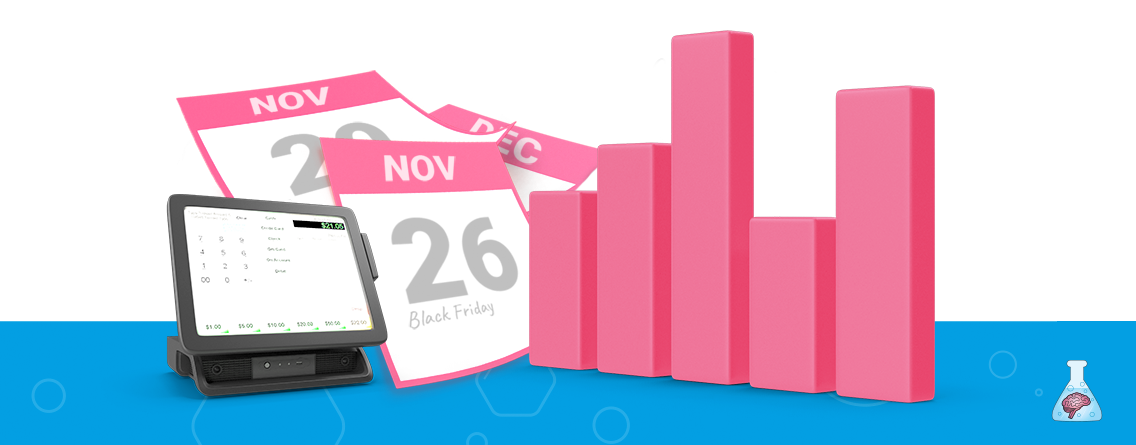Black Friday 2021: why the first ever drop in sales doesn’t tell the whole story
What happened?
2021 was an anomaly in more ways than one, but this Black Friday was particularly remarkable: it represented the first year on record that saw a decrease in online revenue YoY, with e-commerce sales showing a 14% drop YoY in the UK and a 1% drop in the US.
This pattern extended across the whole of Cyber Week which saw a 1.4% YoY drop vs the same period last year according to data from Adobe’s Digital Economy Index1.
However, this does not mean that customers have bucked the trend of increased online shopping. Rather, this is in contrast to the month as a whole; November saw an 11.9% jump year on year2.
We looked under the hood to understand what may be driving this curious trend and how it played out across our client base.
Return to in-store shopping
This time last year, many nations were still in the grip of nationwide lockdowns, with COVID anxiety high and access to stores more limited than they are this year.
As a result, more people were shopping in-store than last year, reducing the demand for online shopping. According to Sensormatic, in the US, in-store traffic was up 47.5% YoY, however this still left footfall in-store over Black Friday 28.3% lower than it was in 20193.
This decrease relative to pre-pandemic times is likely to be driven by a combination of concerns: lingering pandemic anxiety, concerns over the emergence of the Omicron variant, as well as a consumer base who are now more familiar and accustomed to online shopping as an alternative to the in-store experience.
However, in the UK, we found this varied region by region and by shopping venue; in the UK shopping centres saw an 18% YoY rise in footfall while the high street saw a 0.5% drop YoY
(the first footfall drop in the history of Black Friday within the UK)4.
This has in part been driven by the fact that much of the workforce (about 53% according to Google) continue to work from home at least once a week, and the drop in international
tourism over a traditionally busy period in major retail hubs such as London.
An earlier and more ‘sustained’ surge in shopping demand
People have been shopping earlier this year, buying more often across a longer period of time and searching for the best deals. Across the month of November, we saw significant uplift in revenues YoY. According to Adobe5, across the US e-commerce spend during November jumped 11.9% YoY, with 22 days of the month exceeding $3bn in online spending, far exceeding any year previous. This is in contrast to the performance seen on Cyber Week itself, highlighting the impact that higher spending earlier in the month had on overall performance. We saw this trend across much of our client base, ranging from luxury to apparel to gifting, both within revenue and traffic.
This is likely to be driven by 3 factors:
- Supply chain concerns have inspired shoppers to begin and complete their Christmas shopping earlier than ever before. At Brainlabs we saw site traffic remaining stronger throughout October and early November for 2021 vs 20206. The graph below shows a collated and scaled sample from clients across the agency, ranging from all relevant industries and sectors.

- Sales periods started earlier than before, with many brands launching their sales as early as October, inspiring earlier purchases. This spread the demand out over a longer period of time, resulting in a less concentrated shopping surge on Cyber Week in particular while still causing an increase in consumer spending across the whole month.
This was reflected in search behaviour: we can see from Google Trends data that searches for Black Friday started earlier and peaked higher in 2021 vs 20207:

- Inflation has left many brands implementing lower than usual discounts, as they are unable to afford their typical mega price slashes. In fact, according to Salesforce, there was an average inflation of 8.4%, rising to 10% in the UK and 18% in the US8. With prices less appealing, there was less pressure to rush online and snap up a bargain. This was certainly the case across quite a few of our clients, particularly within the fashion space this year.

This is reflected among our clients’ customers; while we did not see a spike in AOV around Black Friday in either 2020 or 2021 (indicating that users were not spending more per transaction over these critical periods, but rather were driving a higher volume of overall transactions),
We did see that 2021 demonstrated a higher AOV across the entire period vs 20209. This was particularly prominent for our clients in the Luxury retail sector as seen to the right here. 
What does this mean for brands?
![]()
 Shopping online is increasingly the ‘first port of call’
Shopping online is increasingly the ‘first port of call’
While this saw a slight drop YoY, the increase over 2019 is still massive and likely to leave a lasting impact on the way that consumers shop in future sales periods.
![]()
 A flattened peak as shopping begins earlier and is sustained across November
A flattened peak as shopping begins earlier and is sustained across November
The supply chain issues exacerbated what was an already forming habit of consumers shopping earlier and earlier each year. Planning ahead and shopping early is fast becoming an established norm: an expectation for brands to phase their discounting and stock availability accordingly.
![]()
 Shifting priorities and a rise of ‘conscious’ consumerism
Shifting priorities and a rise of ‘conscious’ consumerism
A counter trend was an increasing number of brands and consumers who chose to sit out the Black Friday rush. With issues of sustainability and waste reduction top of many peoples’ minds, many feel that events such as Black Friday encourage excessive consumption and big business profiteering. As a result, as many as 85% of independent retailers in the UK sat out this year, refusing to slash prices or offering to re-invest profits from the period in charitable programmes10.
![]()
 How to finish the year strong
How to finish the year strong
We are seeing some of the shopping trends established earlier in the month carrying through to the Christmas run up.
By tapping into these many of our clients are seeing YoY improvements in performance so far in December. These include trends such as ongoing preference to shopping online, which is particularly relevant as many regions are growing increasingly wary of the climbing COVID numbers.
Supply chain concerns remain prevalent, and while shopping is being carried out earlier than normal there will still be a need for last-minute gifts right up until the end of the festive season – ensuring tools such as inventory availability callouts in ads, and clear references to delivery timelines on site and in ad messaging will help address these consumer concerns and drive sales.
Sources:
- Adobe 2021 Digital Economy Index
- Adobe 2021 Digital Economy Index
- CNBC, Nov 2021 https://www.cnbc.com/2021/11/27/black-friday-shopping-in-stores-drops-28percent-from-pre-pandemic-levels.html
- Retail Gazette, Nov 2021
- Adobe 2021 Digital Economy Index
- Brainlabs Client Data – Traffic collated, anonymised and scaled
- Google Trends
- Salesforce https://www.salesforce.com/news/press-releases/2021/12/01/cyber-monday-black-friday-statistics-2021/
- Brainlabs Client Data – AOV collated, anonymised and scaled
- The Guardian, Nov 2021 https://www.theguardian.com/business/2021/nov/21/black-friday-largest-boycott-planned-by-independent-retailers



